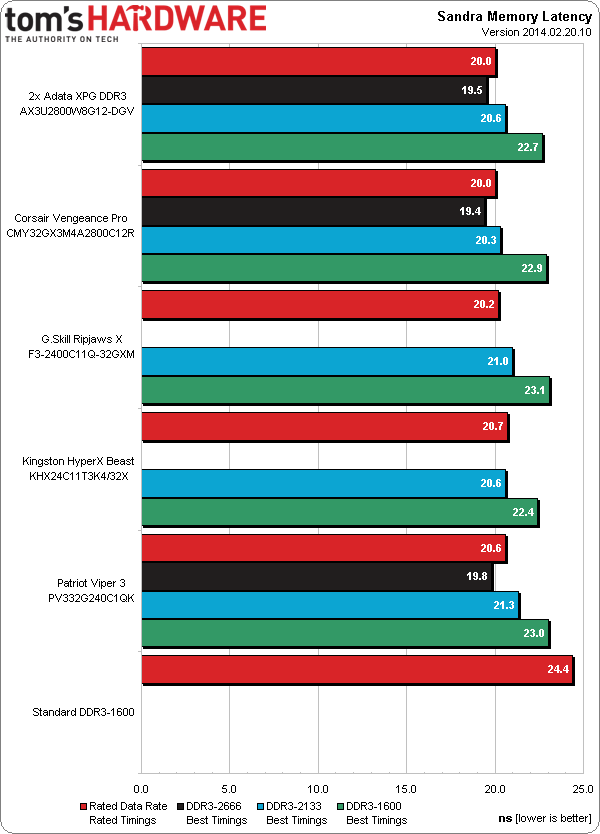Five Overclockable 32 GB DDR3 Kits, Reviewed
Eight gigabytes per DIMM has become de rigueur for high-end builds, even though you get the best data rates and latencies from lower-density modules. We test five 32 GB products to see if it's still possible to squeeze out enthusiast-class performance.
Optimizing Latencies
Both DDR3-2800 samples are rated at 12-14-14-36 timings, and all three DDR3-2400 samples are rated at 11-13-13-3. But both speeds have much more in common when it comes to the lowest stable latencies that provide optimal response times.
| Best Stable Timings | ||||
|---|---|---|---|---|
| Row 0 - Cell 0 | DDR3-1600 | DDR3-2133 | DDR3-2666 | DDR3-2800 |
| 2 x Adata XPG DDR3 AX3U2800W8G12-DGV | 7-8-8-15 | 9-11-10-18 | 12-13-13-24 | 12-14-13-27 |
| Corsair Vengeance Pro CMY32GX3M4A2800C12R | 7-8-7-15 | 9-10-10-18 | 11-13-12-21 | 12-13-13-24 |
| G.Skill Ripjaws X F3-2400C11Q-32GXM | 7-9-8-15 | 10-11-11-18 | N/A | N/A |
| Kingston HyperX Beast KHX24C11T3K4/32X | 7-8-8-15 | 9-11-10-18 | N/A | N/A |
| Patriot Viper 3 PV332G240C1QK | 7-8-7-15 | 10-11-10-18 | 12-13-12-21 | N/A |
Adata's XPG kit required a slightly higher tRAS (the fourth primary timing, above) setting than the other products when I configured it to operate at DDR3-2666. Lower frequencies paved the way for even lower tRAS numbers than the ones in my chart, but without any improvement in the benchmark results.
Corsair’s Vengeance Pro kit was also able to accommodate the lowest primary latencies. That could be important in the search for the absolute-fastest 32 GB kit.
Higher data rates show well in Sandra’s memory latency test, in spite of the absolute higher latency required to get there. That’s partly because latency is counted in cycles, and cycle time is the inverse of frequency.
Get Tom's Hardware's best news and in-depth reviews, straight to your inbox.
Current page: Optimizing Latencies
Prev Page Patriot Viper 3 PV332G240C1QK Next Page Overclocking And Bandwidth-
jasonelmore I've had the Gskill Kit for over a year now and i love it. All these other kits are late to the party.Reply
I use mine for RAM DISK, which is a Asus Program that lets me install games to my RAM and have nearly instant loading times. 10,000 Mbps, where as the fastest m.2 PCIe ssd's will only do 1/10th that.
I cant wait for Broadwell because i need 64GB so i can put a full Battlefield 4 install (42GB and going up with each expansion) on it.
Whats great is the asus RAM DISK program can move the installation freely without you having to mess with the registry or installation directory settings. -
jasonelmore also the Gskill kit is Quad Channel Compatible. i know it's up to the chipset to set channels, but some kits wont work quad channel.Reply -
s3anister @jasonelmore RAM disks have been around for ages and is not an exclusively ASUS thing. Also if you actually NEED that much space on a RAM disk then you'd be better served by using an LGA2011 platform since you could easily drop 64GB in it.Reply -
Amdlova i have used g-skill on my last 3 builds and work hard. never get an blue scren. but with corsairs i lost my count. i prefer use kingston value ram to buy corsair memory againReply -
Crashman Reply
All of these kits are designed for Quad-Channel mode, but the Quad-Channel CPUs we have won't push the high data rates needed for a memory overclocking evaluation.13325424 said:also the Gskill kit is Quad Channel Compatible. i know it's up to the chipset to set channels, but some kits wont work quad channel.
-
jasonelmore Reply@jasonelmore RAM disks have been around for ages and is not an exclusively ASUS thing. Also if you actually NEED that much space on a RAM disk then you'd be better served by using an LGA2011 platform since you could easily drop 64GB in it.
The connectivity on LGA 2011 is behind quite a bit. I'd rather have faster IPC, and more than 2 native sata 6g. I wish intel would not keep it's enthusiast line a year behind in tech. -
mapesdhs I've used a lot of GSkill kits, they're very good, but one thing surprises me aboutReply
the choice, namely the absence of the GSkill TridentX kit. I find it's more stable
than the Ripjaws series, especially in max-RAM configurations with 32GB on Z68,
or 64GB on X79, etc. I wonder why GSkill chose to supply the RipjawsX... I was
going to say maybe it was just price, but TridentX is cheaper now, at least in the
UK anyway, but even if it cost more I'd still always recommend the TridentX if a
buyer can afford it. Note the TridentX is CL10 vs. the RipjawsX's CL11. Here's my
config with two TridentX 2400 kits, set for the moment at 2133 as that was my
target speed (at the time it was cheaper than buying native 2133 kits, and I've
not had a chance yet to optimise at 2400):
http://valid.canardpc.com/r9ibvb
Ian.
-
Vlad Rose I have been using G.Skill RAM since the early days of the Athlon when no one had heard of the company. It has always been rock solid for me and have had great luck overclocking it over the years.Reply -
damric I can run my G.Skill 2133CL10s at 2500CL10 rock solid on an Athlon 760K so suck it, intel!Reply

